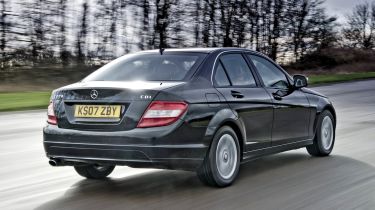Mercedes C220 CDI SE
Smooth and sophisticated, the C-Class is a strong challenger
SPOILED for choice. That’s what you’ll be if you buy a Mercedes C-Class. After all, you don’t simply have to worry about which colour and wheels to go for – you also get a choice of two different noses.
The entry-level SE tested here has the stately grille with three-pointed star above it, rather than the central badge of sportier models. However, without the chrome touches of higher-spec versions, it appears slightly dull. The black paint and standard 16-inch wheels of our car don’t help to show off the saloon’s lines, and it’s only the shapely headlights and distinctive door mirrors which stand out. That’s disappointing, because we know the C-Class can look quite glamorous.
Still, the low-key exterior ties in with the cockpit. It’s well put together, but visually it seems a bit cheap, with a finish that’s more A-Class than S-Class. The dials look rather low-rent, while the single multifunction column stalk is annoying. It sits too low, and you’ll find it all too easy to flick the wipers on when you indicate, or flash the main beam instead of washing the screen.
Restoring an upmarket air are the piano black trim, weighty metal door handles and thin chrome detailing strips, and all versions of the C-Class feature a smart climate control system.
While the driving position is widely adjustable, the chairs are short on side support. The rear bench is also too flat, and space is at a premium, just as it is in the 3-Series. But it’s still acceptable for two adults either side of the huge transmission tunnel, and the extra footroom over the BMW is welcome. There is a decent boot and reasonable cabin stowage, including a useful centre console tray with a sliding cover.
The Mercedes has a sedate air that’s carried through to the way it drives. As with all non-Sport models, this SE is softly sprung, so there is plenty of body movement even at low speed. Urban potholes are soaked up well, while speed humps are easily absorbed.
But the trade-off for this is excessive body roll. While the dampers do a good job of absorbing bumps, there is lots of lean through bends.
The light steering isn’t especially sharp, and the huge wheel takes the edge off the driving experience. It feels like a ship’s tiller, while body movement is unsettling over twisty roads. As a result, the Audi and BMW are far more reassuring. It’s worth noting, though, that the Sport-spec C-Class has more focused settings which transform the driving experience.
The 2.2-litre CDI engine is a strong performer. With 170bhp and a huge 400Nm of torque, it delivers impressive acceleration and in-gear pace, and gives the Mercedes a muscular feel on the road. It’s clattery at tickover and low revs, but smooths out with speed.
Although the six-speed gearbox is decent, its action is marred by a springy, long-travel clutch and a throttle pedal that requires exaggerated inputs. So there’s plenty of legwork in town, and you could even do with an extra leg when you come to stop, due to the old-fashioned, foot-operated parking brake.
Surprisingly, the £25,107 Mercedes isn’t the most expensive car here, despite having seven airbags, Bluetooth and two-zone climate control as standard. The only big omissions are parking sensors and cruise control. Will thathold back the C-Class’s challenge?
Details
Price: £25,107
Model tested: C220 CDI SE
Chart position: 3
WHY: Sharp-looking and great to drive, the latest C-Class is a stronger contender than ever.
Economy
Despite having a bigger output, the Mercedes returned 38.4mpg in its time with us. A drag factor of 0.27Cd helped, and at a steady cruise we saw over 45mpg.
Residuals
The C220 CDI is predicted to retain 46.5 per cent of its value over three years. That’s just under one per cent better than the 320d, but well ahead of the Mondeo.
Servicing
Mercedes garages were ranked 18th in our Driver Power survey, while a quote of £880 for three services makes the C220 the costliest car to maintain.
Tax
At 156g/km, the C-Class puts out 28g/km more CO2 than the 320d, so it falls in the 21 per cent bracket. It will cost higher-band business users £2,109 a year in tax.






